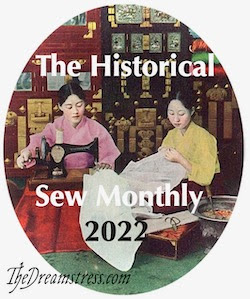The Challenge: Innovation
Fabric: Cotton
Pattern: Past Patterns #8159 Ladies' Dress with Two Piece Skirt, Documented to Novemer 1917
Original Pattern: McCall Pattern No. 8159 Patented April 21, 1908 20 cents
Year: 1908 - 1917
Notions: Buttons, Snap Fasteners
How historically accurate is it? The pattern and sewing techniques are historically accurate. The use of the Downton Abbey print is, of course, not accurate, but the use of cotton fabric is accurate. So.....90%?
Hours to complete? 16 hours
First Worn: Made for the Downton Abbey Costume Exhibition at Winterthur Museum, Spring 2014.
Total Cost: Buttons $3.52, Pattern $16.00, Fabric $50.00 = $69.52
Creativity is thinking up new things.
Innovation is doing new things.
Theodore Levitt
But then I remembered seeing a great dress pattern that I had once thought would be perfect for the Downton Abbey Costume Exhibition at the Winterthur Museum next spring. A little internet searching and I found the pattern on the Past Patterns website. Yay! And what kind of hat was being worn in the inspiration? One just like my $3.00 beauty! I wanted a nice cotton for this dress and discovered that a new line of quilting cottons had been released in the Downton Abbey theme. Another search and I found a 4 yard piece on ebay for $50.00. It wasn't enough to make the dress but I had a tiny piece of contrast fabric in my stash that I thought would coordinate and luckily it did.
The pattern is one-sized and I would have to rescale it to fit me. Something I'm not experienced doing. So I cut the pattern and pinned the paper pattern pieces to my dressform. This gave me a general idea of the construction of the dress and where I would need to add to the pattern's dimensions.
Some measuring, some additions, some mistakes, some corrections, and several mock-ups later I have done it! Of course I'm thrilled that I figured this out and did this!
Before I start to cut the fashion fabric I start a little side project for my hat decoration. This is 1-1/2" wired ribbon and Tulip Soft Fabric Paint in turquoise. I mix some of the paint with water, dip my coiled ribbon in it until I get the saturation I want and then let it dry in a glass bowl.
It turns out to be a beautiful variegated ribbon.....
which I sew into a turquoise Tea Rose.
So back to creating the dress. I had to be very very careful with my cutting as I wanted the "Abbey" part of the pattern situated on the center of the back and bodice, the center of the skirt front, and the center of the sleeves. To do this I cut each piece individually and then laid the cut piece on the fabric with right sides facing and mirrored the pattern.
I had inches of fabric to spare! And in my rescaling and pattern matching I made a terrible error. I was short fabric on the left bodice front shoulder and cut into my fabric on the right bodice front shoulder. Oh no! These pieces would be so visible and I had no fabric left over!
Now we get to the Innovation. Snap Fasteners! In the directions Item (2) says "fasten with snaps." It is referring to the bodice pieces as they overlap each other. A snap fastener is a pair of interlocking discs made of metal, or today of plastic, and used to fasten clothing. Like buttons, the concept is actually ancient and a form can be traced back to 210 BC on horse halters. The modern snap fastener was first patented by German inventor Heribert Bauer in 1885 as the "Federknopf-Verschluss". It was a fastener for men's trousers. The invention was sold to a German company in 1903 who started production and marketing that year. Prym is still the leading European producer of snap fasteners. When James McCall patented his dress design and pattern in 1908, the snap fastener for a ladies' dress would have been a wonderful innovation that had become mainstream in a few short years.
In my fastener inventory I had the snap studs which became popular in the 1930's by rodeo cowboys for quick release of their shirts for safety, snap fasteners which attach with metal teeth, and clear sew-on snap fasteners. While the clear snap fasteners would not have been available in 1908, the sew on method was very period correct for this dress.
A touch of contrast fabric, a touch of turquoise with buttons, and the Downton Abbey dress is complete!
Although the Exhibition is months away, I couldn't resist having a little photo fun with my new creation!
Love,
Jeanette
.jpg)














































Jeanette, I thought this dress was so pretty when I saw you wearing it at Costume College and saved your photo because I thought someday I'd like to try that pattern. And here we are today, getting my ideas together for it, and waiting for the pattern to arrive.
ReplyDeleteI hope mine turns out as beautiful as yours, but the fitting scares me a bit. A muslin will be my friend.
Val